新穎材料農業:農業新穎材料在植物保健開發、應用與機理【植物病理學系/王智立副教授/優聘教師】
| 論文篇名 | 英文:First report of powdery mildew on Bidens pilosa var. radiata and Passiflora edulis f. flavicarpa caused by Golovinomyces circumfusus in Taiwan 中文:由Golovinomyces circumfusus 引起之大花咸豐草白粉病及百香果白粉病於台灣的首次報導 |
| 期刊名稱 | Journal of Plant Pathology |
| 發表年份,卷數,起迄頁數 | 2020, 102, 541-542 |
| 作者 | Lin, Tsung-Chun; Dai, Yu-Lun; You, Cing-Siang; Huang, Jenn-Wen(黃振文); Wang, Chih-Li(王智立)* |
| DOI | 10.1007/s42161-019-00431-2 |
| 中文摘要 | 大花咸豐草Bidens pilosa var. radiata(簡稱BPR)是一種野草,因其潛在的抗炎、抗過敏和抗癌活性而被推薦使用。 BPR的白粉病在台灣低海拔農業區的10月至2月期間普遍發生,但對該病的病原菌缺乏詳細的鑑定。從2016年開始,該病在台灣台中有機種植BPR的農場發生率100%。白色菌絲體最初在罹病BPR的下位葉和莖表面呈菌落狀分布,然後延伸到全莖葉。出乎意料的是,在罹病 BPR 旁邊生長的百香果 (Passiflora edulis Sims f. flavicarpa O. Deg) 幼苗也顯示出白粉病的病徵。在苗圃中,百香果幼苗的平均發病率為10-20%。為了檢查兩種寄主植上的病原菌之親緣關係,分別從罹病的 BPR 和百香果中擴增了內部轉錄間隔區 (ITS) 基因(GenBank 登錄號 MH590730 和 MH590731)的序列。親緣分析表明,來自 BPR 和百香果的分離株聚集在一個可靠的演化支序中,具有 99% 的bootstrap value,其中包含3種 Golovinomyces (U. Braun) V.P. Heluta,包括 G. ambrosiae (Schwein.) U. Braun & R.T.A. Cook, G. spadiceus (Berk. & M.A. Curtis) U. Braun 和 G. circumfusus (Schltdl.) U. Braun。由於ITS和28S序列不容易區分這3個物種,因此以形態特徵鑑定此2種病原菌。病原菌的分生孢子為 32-47 X 15-22 μm,橢圓形至亞圓柱形,長/寬比為 1.6-2.7,無纖維體。簡單的發芽管著生在分生孢子亞末端到橫向位置。分生孢子梗是直立的,由一個圓柱形足細胞(28-106 X 9-14 μm)、接連1-3 個細胞和具有彎曲邊緣線的連生分生孢子串組成。附著器是乳頭狀單生的。沒有觀察到閉囊殼。兩種病原菌的形態特徵與G. circumfusus的描述一致。將分生孢子從罹病的 BPR 和百香果植物葉子接種到健康植株,在相互接種試驗中評估致病性。未接種的BPR 和百香果植物作為對照組。接種和未接種的植物在 24°C 的生長室中培養 14 天。在接種 BPR 和百香果的植物上出現白粉病徵,但在對照組植物上沒有出現。進一步從接種植物中再分離到相同的病原菌,完成科霍氏法則。這是關於 G. circmfusus 於大花咸豐草及百香果引起白粉病在台灣和世界的首次報導。 |
| 英文摘要 | Bidens pilosa L. var. radiata Sch. Bip. (abbreviated as BPR) is a wild grass recommended for its potential antiinflammatory, antiallergic and anti-cancer activities. Powdery mildew of BPR commonly occurred during October to February in low-altitude agricultural areas of Taiwan, but a detailed identification of the causal agent of the disease was lacking. From 2016, the disease occurred 100% in organic monocrop farms of BPR in Taichung, Taiwan. White mycelia initially were in patches on the surface of lower leaves and stems of diseased BPR, and then became effuse. Unexpectedly, seedlings of passionfruit (Passiflora edulis Sims f. flavicarpa O. Deg) growing next to diseased BPR showed powdery mildew signs and symptoms as well. In nurseries, the average disease incidence on passionfruit seedlings was 10-20 %. To examine the phylogenetic relationship of the pathogens on two host plants, sequences of Internal Transcribed Spacer (ITS) gene (GenBank accession nos. MH590730 and MH590731) were amplified from diseased BPR and passionfruit, respectively. The phylogenetic analysis indicated that isolates from BPR and passionfruit plants clustered in a reliable clade with a 99% bootstrap value containing three species of Golovinomyces (U. Braun) V.P. Heluta, including G. ambrosiae (Schwein.) U. Braun & R.T.A. Cook, G. spadiceus (Berk. & M.A. Curtis) U. Braun and G. circumfusus (Schltdl.) U. Braun. As indicated that the three species were not readily to be distinct by ITS and 28S sequences, the morphological features were used for the identification at species level of the two pathogens. Conidia of the pathogens were 32-47 X 15-22 μm, ellipsoid-oval to sub-cylindrical, with a length/width ratio of 1.6-2.7, and lacking fibrosin bodies. Simple germ tubes were observed on subterminal to lateral positions. Conidiophores were erect and consisting of a cylindrical foot cell (28-106 X 9-14 μm), 1-3 following cells and catenescent conidia with sinuous edge line. Appressoria were solitary and slightly to distinctly nipple-shaped. No chasmothecia were observed. Morphological characteristics of the two pathogens were in agreement with the description of G. circumfusus. The pathogenicity was assessed in reciprocal inoculation assays by dusting the conidia from diseased to healthy BPR and passionfruit plant leaves. Un-inoculated plants of BPR and passionfruit were used as controls. Inoculated and un-inoculated plants were incubated in a growth chamber at 24°C for 14 days. Powdery mildew signs and symptoms developed on inoculated plants of BPR and passionfruit but not on control plants. The identical pathogen was recovered from inoculated plants which fulfilled the Koch’s postulates. This is the first report of G. circumfusus as causal agent of powdery mildew on Bidens pilosa var. radiata and P. edulis f. flavicarpa in Taiwan and worldwide. |
| 發表成果與本中心研究主題相關性 | 本研究發現百香果嫁接苗出現白粉病,經由完成科霍氏法則及交叉接種,證明大花咸豐草白粉病與百香果白粉病為同一種病原菌所引起,以形態及分子特徵進一步證實兩種病原菌為同一種類,這是關於 G. circumfusus 於大花咸豐草及百香果引起白粉病在台灣和世界的首次報導。研究成果說明大花咸豐草為百香果白粉病菌的中間寄主,有助於未來進行百香果白粉病田間的病害管理策略的參考,使百香果產業得以永續發展。 |







